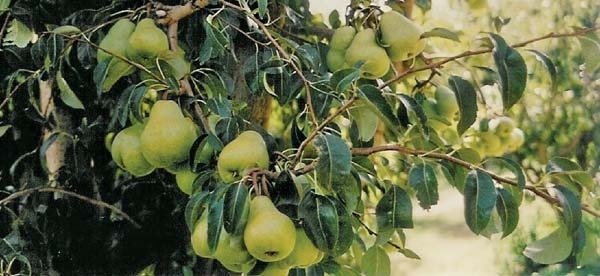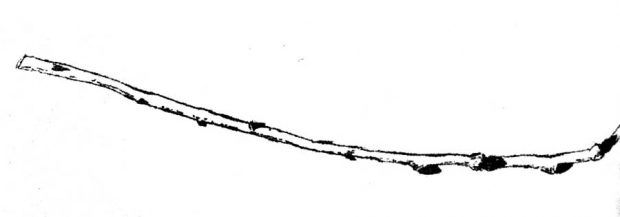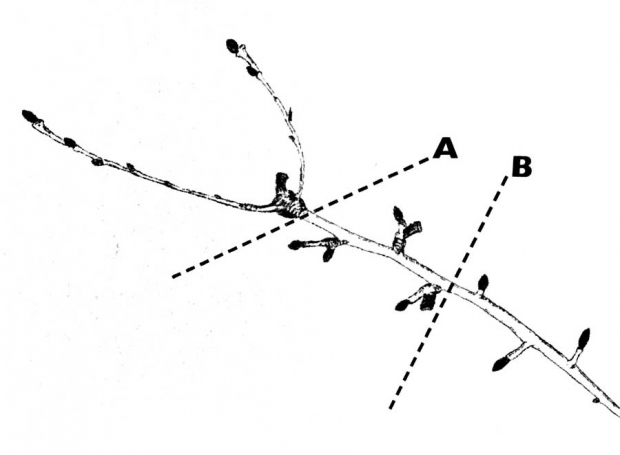Editor’s note:
This story was updated in 2020 — Good to Know: The 1-2-3 rule for renewal pruning

The largest and best quality apples and pears grow on two-year-old wood and young spurs. To develop two-year-old wood, prune trees according to the 1-2-3 rule of renewal pruning. This rule ensures that the fruiting wood remains young and productive. Your trees are as young as the fruiting wood. Using a pear tree as an example, here is how you use the 1-2-3 rule.
1. The 1 of the 1-2-3 rule refers to the one-year-old laterals, also called pencils. These laterals are 300 to 400 mm (12 to 16 inches) long and a little thinner than a pencil. The buds at the tips are often fruit buds (Figure 1). Never shorten these laterals. If you have too many, space them out and keep the ones that are horizontal and almost as thick as a pencil.
Remove the strong upright shoots and long laterals without fruit buds at the tips. These are nonproductive growth shoots. However, some pear varieties, such as Forelle and Beurre Bosc, often do not produce one-year-old laterals with fruit buds at the tips. If left untipped, these laterals will bud up in the second year.
Also remove the very thin laterals, because these will not produce the quality and sizes of fruit that the market wants.
About one-third of the renewal wood should be one year old.
(On young, nonbearing Bartlett and Forelle trees on Open Tatura with 2,000 trees per hectare or 800 trees per acre, we have used Ethrel sprays in mid- and late summer to terminate extension growth of laterals. This method of vigor control often resulted in laterals setting terminal fruit buds. Ethrel was sprayed [without a wetting agent] at the rate of 300 to 700 millilitres per hectare [4 to 10 ounces per acre] three to five times. The differences in rates depended on the temperature in the orchard after spraying. A low rate was used when it was hot, and a high rate when it was cool. The active constituent of Ethrel was 480 grams per litre of ethephon.)
2. The 2 in 1-2-3 refers to fruiting wood that is now two years old. This two-year-old wood has had one or more pears at the tip last year and has now spurred up. The fruit bud at the tip has also grown one or two bourse shoots (Figure 2).
How you prune this two-year-old wood depends on the number of buds and the vigor of the trees. Here are two options:
• Cut back to the “ring.” This is the division between the one- and two-year-old wood. This cut is called the “ring” or “fertility” cut, because it improves fruit set (Figure 2, A).
• Cut deeper than the ring to reduce the number of fruit buds. Often you find differences in the fruitfulness of this wood on the same tree. Cut deeper when the wood is weaker (Figure 2, B).
About one-third of the renewal wood should be two years old.
3. The 3 in 1-2-3 refers to three-year-old wood which was cropped when two years old and sometimes one year old. Renew the three-year-old wood by cutting it back hard (Figure 3). This way you will generate new laterals, and the cycle starts again (Figure 4). You may leave some good young fruiting spurs on this three-year-old wood, but you must cut back hard to get new laterals.
About one-third of the renewal wood should be three years old.
Simple
The 1-2-3 rule of renewal pruning is simple and less expensive than spur pruning, and it ensures that your trees do not develop old, tired spurs that produce fruit of poor quality and size. This rule also avoids biennial bearing, provided there has been adequate cross-pollination.
The 1-2-3 rule is very effective if you keep your trees calm. Calm trees have dominant leaders that are not forked and have stubs and small secondary branches that carry the one-, two-, and three-year- old wood.




Van den Ende is a tree fruit consultant in Australia’s Goulburn Valley.

I really like this article. Very simple and straight forward method. I have many 1st year pencils that are much longer than 16 inches. Your article says to not cut them back, but they will be about 4-5 feet if I leave them. Any suggestions?
Hello Robert,
I think you should not cut or head your pencils because cutting them back will further produce laterals which will result in more blindfold or unproductive wood. You should wait for second year when a ring is formed and should cut back to the ring to have more fruit buds.
How does the 1-2-3 rule apply to espalier fruits?
thank you goodfruit for giving me wonderful information
Thank you for the well-explained information, it’s a really great reference point to go off of when we take part in pruning.
It’s good to see knowledge being spread around. More people need to know how to properly prune their trees.
Great advice for proper tree pruning. Our company will definitely utilize this moving forward!
Our landscaping business will benefit from this a lot. We have to prune trees and bushes quite a lot even though a tree company would do a better job. Helping us in this way is very appreciated. Thank you!
Thanks for the information. Found it very useful. Is it advisable to cut back to the ring even during the summer when the ring has been formed? I am an apple grower.
Great advice on pruning. This is one of the things most garden ownders miss. Greetings from Germany.
Awesome tips on pruning your trees!